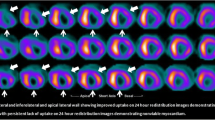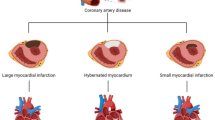Abstract
Purpose of Review
We aim to reevaluate how the assessment of myocardial viability can guide optimal treatment strategies for patients with ischemic cardiomyopathy (ICM) based on a more contemporary understanding of the mechanism of benefit of revascularization.
Recent Findings
The assessment of viability in left ventricular (LV) segments with diminished contraction has been proposed as key to predict the benefit of revascularization and, therefore, as a requisite for the selection of patients to undergo this form of treatment. However, data from prospective trials have diverged from earlier retrospective studies.
Summary
Traditional binary viability assessment may oversimplify ICM’s complexity and the nuances of revascularization benefits. A conceptual shift from the traditional paradigm centered on the assessment of viability as a dichotomous variable to a more comprehensive approach encompassing a thorough understanding of ICM’s complex pathophysiology and the salutary effect of revascularization in the prevention of myocardial infarction and ventricular arrhythmias is required.

Similar content being viewed by others
Abbreviations
- AMI:
-
Acute myocardial infarction
- CABG:
-
Coronary artery bypass grafting
- CAD:
-
Coronary artery disease
- EF:
-
Ejection fraction
- HF:
-
Heart failure
- ICM:
-
Ischemic cardiomyopathy
- IHD:
-
Ischemic heart disease
- LV:
-
Left ventricular
- LVEF:
-
Left ventricular ejection fraction
- MI:
-
Myocardial infarction
- cMRI:
-
Cardiac magnetic resonance imaging
- OMT:
-
Optimal medical therapy
- PCI:
-
Percutaneous coronary intervention
- PET:
-
Positron emission tomography
- RCTs:
-
Randomized control trials
- SPECT:
-
Single-photon emission computed tomography
References
Papers of particular interest, published recently, have been highlighted as: • Of importance •• Of major importance
Khan MA, Hashim MJ, Mustafa H, Baniyas MY, Al Suwaidi S, AlKatheeri R, et al. Global epidemiology of ischemic heart disease: results from the global gurden of disease study. Cureus. 2020;12(7): e9349. https://doi.org/10.7759/cureus.9349.
Zhang L, Tong Z, Han R, Guo R, Zang S, Zhang X, et al. Global, regional, and national burdens of ischemic heart disease attributable to smoking from 1990 to 2019. J Am Heart Assoc. 2023;12(3): e028193. https://doi.org/10.1161/JAHA.122.028193.
Moran AE, Forouzanfar MH, Roth GA, Mensah GA, Ezzati M, Flaxman A, et al. The global burden of ischemic heart disease in 1990 and 2010: the global burden of disease 2010 study. Circulation. 2014;129(14):1493–501. https://doi.org/10.1161/CIRCULATIONAHA.113.004046.
Felker GM, Shaw LK, O’Connor CM. A standardized definition of ischemic cardiomyopathy for use in clinical research. J Am Coll Cardiol. 2002;39(2):210–8. https://doi.org/10.1016/s0735-1097(01)01738-7.
Rahimtoola SH. A perspective on the three large multicenter randomized clinical trials of coronary bypass surgery for chronic stable angina. Circulation. 1985;72(6 Pt 2):V123–35.
Panza JA, Chrzanowski L, Bonow RO. Myocardial viability assessment before surgical revascularization in ischemic cardiomyopathy: JACC review topic of the week. J Am Coll Cardiol. 2021;78(10):1068–77. https://doi.org/10.1016/j.jacc.2021.07.004.
Rahimtoola SH. The hibernating myocardium. Am Heart J. 1989;117(1):211–21. https://doi.org/10.1016/0002-8703(89)90685-6.
Vanoverschelde JL, Wijns W, Depre C, Essamri B, Heyndrickx GR, Borgers M, et al. Mechanisms of chronic regional postischemic dysfunction in humans. New insights from the study of noninfarcted collateral-dependent myocardium. Circulation. 1993;87(5):1513–23. https://doi.org/10.1161/01.cir.87.5.1513.
Shen YT, Vatner SF. Mechanism of impaired myocardial function during progressive coronary stenosis in conscious pigs. Hibernation versus stunning?. Circ Res. 1995;76(3):479–88. https://doi.org/10.1161/01.res.76.3.479.
Briceno N, Schuster A, Lumley M, Perera D. Ischaemic cardiomyopathy: pathophysiology, assessment and the role of revascularisation. Heart. 2016;102(5):397–406. https://doi.org/10.1136/heartjnl-2015-308037.
Garcia M, Kwong R, Scherrer-Crosbie M, Taub C, Blankstein R, Lima J, et al. American heart association council on cardiovascular radiology and intervention and council on clinical cardiology. state of the art: imaging for myocardial viability: a scientific statement from the american heart association. Circ cardiovasc imaging. 2020;13(7):e000053. https://doi.org/10.1161/HCI.0000000000000053.
Bax JJ, Poldermans D, Elhendy A, Boersma E, Rahimtoola SH. Sensitivity, specificity, and predictive accuracies of various noninvasive techniques for detecting hibernating myocardium. Curr Probl Cardiol. 2001;26(2):147–81. https://doi.org/10.1067/mcd.2001.109973.
Di Carli MF, Asgarzadie F, Schelbert HR, Brunken RC, Laks H, Phelps ME, et al. Quantitative relation between myocardial viability and improvement in heart failure symptoms after revascularization in patients with ischemic cardiomyopathy. Circulation. 1995;92(12):3436–44. https://doi.org/10.1161/01.cir.92.12.3436.
Allman KC, Shaw LJ, Hachamovitch R, Udelson JE. Myocardial viability testing and impact of revascularization on prognosis in patients with coronary artery disease and left ventricular dysfunction: a meta-analysis. J Am Coll Cardiol. 2002;39(7):1151–8. https://doi.org/10.1016/s0735-1097(02)01726-6.
Inaba Y, Chen JA, Bergmann SR. Quantity of viable myocardium required to improve survival with revascularization in patients with ischemic cardiomyopathy: a meta-analysis. J Nucl Cardiol. 2010;17(4):646–54. https://doi.org/10.1007/s12350-010-9226-2.
Cleland JG, Calvert M, Freemantle N, Arrow Y, Ball SG, Bonser RS, et al. The heart failure revascularisation trial (HEART). Eur J Heart Fail. 2011;13(2):227–33. https://doi.org/10.1093/eurjhf/hfq230.
Beanlands RS, Nichol G, Huszti E, Humen D, Racine N, Freeman M, et al. F-18-fluorodeoxyglucose positron emission tomography imaging-assisted management of patients with severe left ventricular dysfunction and suspected coronary disease: a randomized, controlled trial (PARR-2). J Am Coll Cardiol. 2007;50(20):2002–12. https://doi.org/10.1016/j.jacc.2007.09.006.
Velazquez EJ, Lee KL, O’Connor CM, Oh JK, Bonow RO, Pohost GM, et al. The rationale and design of the surgical treatment for ischemic heart failure (STICH) trial. J Thorac Cardiovasc Surg. 2007;134(6):1540–7. https://doi.org/10.1016/j.jtcvs.2007.05.069.
Velazquez EJ, Lee KL, Jones RH, Al-Khalidi HR, Hill JA, Panza JA, et al. Coronary-artery bypass surgery in patients with ischemic cardiomyopathy. N Engl J Med. 2016;374(16):1511–20. https://doi.org/10.1056/NEJMoa1602001.
Bonow RO, Maurer G, Lee KL, Holly TA, Binkley PF, Desvigne-Nickens P, et al. Myocardial viability and survival in ischemic left ventricular dysfunction. N Engl J Med. 2011;364(17):1617–25. https://doi.org/10.1056/NEJMoa1100358.
•• Panza JA, Ellis AM, Al-Khalidi HR, Holly TA, Berman DS, Oh JK, et al. Myocardial viability and long-term outcomes in ischemic cardiomyopathy. N Engl J Med. 2019;381(8):739–48. https://doi.org/10.1056/NEJMoa1807365. This prespecified subanalysis of the STICH trial demonstrated that binary classification of patients according to the presence of viable myocardium did not interact with the treatment effect of revascularization.
Panza JA, Holly TA, Asch FM, She L, Pellikka PA, Velazquez EJ, et al. Inducible myocardial ischemia and outcomes in patients with coronary artery disease and left ventricular dysfunction. J Am Coll Cardiol. 2013;61(18):1860–70. https://doi.org/10.1016/j.jacc.2013.02.014.
O’Fee K, Panza JA, Brown DL. Association of inducible myocardial ischemia with long-term mortality and benefit from coronary artery bypass graft surgery in ischemic cardiomyopathy: ten-year follow-up of the STICH trial. Circulation. 2021;143(2):205–7. https://doi.org/10.1161/CIRCULATIONAHA.120.050734.
•• Perera D, Clayton T, O’Kane PD, Greenwood JP, Weerackody R, Ryan M, et al. Percutaneous revascularization for ischemic left ventricular dysfunction. N Engl J Med. 2022;387(15):1351–60. https://doi.org/10.1056/NEJMoa2206606. This was the first prospective study comparing revascularization with PCI compared to medical therapy in patients with ICM.
•• Perera D CA, Ryan M, Morgan H, Weerackodye R, O’Kane P, De Silva K, Dixon LJ, Nazir S, Mancio J, Alskaf E, Masci PG, Dodd M, Clayton T, Kapetanakis S, McDiarmid AK, McCann GP, Petrie M, Greenwood JP: Effect of myocardial viability, percutaneous coronary intervention and functional recovery on clinical outcomes in the REVIVED-BCIS2 randomized trial. Available at https://www.abstractsonline.com/pp8/#!/10674/presentation/20478 (2023). Accessed 5/30/2023. This preliminary findings of this pre-specified analysis found no association between viable myocardium extent and survival or LVEF recovery in ICM patients after PCI.
Orlandini A, Castellana N, Pascual A, Botto F, Bahit MC, Chacon C, et al. Myocardial viability for decision-making concerning revascularization in patients with left ventricular dysfunction and coronary artery disease: a meta-analysis of non-randomized and randomized studies. Int J Cardiol. 2015;182:494–9. https://doi.org/10.1016/j.ijcard.2015.01.025.
Bello D, Shah DJ, Farah GM, Di Luzio S, Parker M, Johnson MR, et al. Gadolinium cardiovascular magnetic resonance predicts reversible myocardial dysfunction and remodeling in patients with heart failure undergoing beta-blocker therapy. Circulation. 2003;108(16):1945–53. https://doi.org/10.1161/01.CIR.0000095029.57483.60.
Cleland J, Pennell D, Ray S, Coats A, Macfarlane P, Murray G, et al. Myocardial viability as a determinant of the ejection fraction response to carvedilol in patients with heart failure (CHRISTMAS trial): randomised controlled trial. The Lancet. 2003;362(9377):14–21. https://doi.org/10.1016/s0140-6736(03)13801-9.
• Perry AS, Mann DL, Brown DL. Improvement of ejection fraction and mortality in ischaemic heart failure. Heart. 2021;107(4):326–31. https://doi.org/10.1136/heartjnl-2020-316975. This subanalysis demonstrated that EF improvement > 10% correlated with reduced mortality but was independent of treatment modality, suggesting other mechanisms for CABG’s survival benefits.
Panza JA, Velazquez EJ, She L, Smith PK, Nicolau JC, Favaloro RR, et al. Extent of coronary and myocardial disease and benefit from surgical revascularization in ischemic LV dysfunction. J Am Coll Cardiol. 2014;64(6):553–61. https://doi.org/10.1016/j.jacc.2014.04.064.
Carson P, Wertheimer J, Miller A, O’Connor CM, Pina IL, Selzman C, et al. The STICH trial (surgical treatment for ischemic heart failure): mode-of-death results. JACC Heart Fail. 2013;1(5):400–8. https://doi.org/10.1016/j.jchf.2013.04.012.
Neumann FJ, Sousa-Uva M, Ahlsson A, Alfonso F, Banning AP, Benedetto U, et al. 2018 ESC/EACTS guidelines on myocardial revascularization. Eur Heart J. 2019;40(2):87–165. https://doi.org/10.1093/eurheartj/ehy394.
Writing Committee M, Lawton JS, Tamis-Holland JE, Bangalore S, Bates ER, Beckie TM, et al. 2021 ACC/AHA/SCAI guideline for coronary artery revascularization: a report of the american college of cardiology/american heart association joint committee on clinical practice guidelines. J Am Coll Cardiol. 2022;79(2):e21–129. https://doi.org/10.1016/j.jacc.2021.09.006.
Volz S, Redfors B, Angeras O, Ioanes D, Odenstedt J, Koul S, et al. Long-term mortality in patients with ischaemic heart failure revascularized with coronary artery bypass grafting or percutaneous coronary intervention: insights from the Swedish Coronary Angiography and Angioplasty Registry (SCAAR). Eur Heart J. 2021;42(27):2657–64. https://doi.org/10.1093/eurheartj/ehab273.
• Sun LY, Gaudino M, Chen RJ, Bader Eddeen A, Ruel M. Long-term outcomes in patients with severely reduced left ventricular ejection fraction undergoing percutaneous coronary intervention vs coronary artery bypass grafting. JAMA Cardiol. 2020;5(6):631–41. https://doi.org/10.1001/jamacardio.2020.0239. This study demonstrated superiority of CABG over PCI in ICM patients in the largest retrospective analysis to date.
Ambrose JA, Tannenbaum MA, Alexopoulos D, Hjemdahl-Monsen CE, Leavy J, Weiss M, et al. Angiographic progression of coronary artery disease and the development of myocardial infarction. J Am Coll Cardiol. 1988;12(1):56–62. https://doi.org/10.1016/0735-1097(88)90356-7.
Doenst T, Haverich A, Serruys P, Bonow RO, Kappetein P, Falk V, et al. PCI and CABG for treating stable coronary artery disease: JACC review topic of the week. J Am Coll Cardiol. 2019;73(8):964–76. https://doi.org/10.1016/j.jacc.2018.11.053.
Schwartz L, Kip KE, Frye RL, Alderman EL, Schaff HV, Detre KM, et al. Coronary bypass graft patency in patients with diabetes in the bypass angioplasty revascularization investigation (BARI). Circulation. 2002;106(21):2652–8. https://doi.org/10.1161/01.cir.0000038885.94771.43.
Farooq V, Serruys PW, Bourantas CV, Zhang Y, Muramatsu T, Feldman T, et al. Quantification of incomplete revascularization and its association with five-year mortality in the synergy between percutaneous coronary intervention with taxus and cardiac surgery (SYNTAX) trial validation of the residual SYNTAX score. Circulation. 2013;128(2):141–51. https://doi.org/10.1161/CIRCULATIONAHA.113.001803.
Stone GW, Ali ZA, O’Brien SM, Rhodes G, Genereux P, Bangalore S, et al. Impact of complete revascularization in the ISCHEMIA trial. J Am Coll Cardiol. 2023;82(12):1175–88. https://doi.org/10.1016/j.jacc.2023.06.015.
Chaitman BR, Alexander KP, Cyr DD, Berger JS, Reynolds HR, Bangalore S, et al. Myocardial infarction in the ISCHEMIA trial. Circulation. 2021;143(8):790–804. https://doi.org/10.1161/CIRCULATIONAHA.120.047987.
Fremes SE, Marquis-Gravel G, Gaudino MFL, Jolicoeur EM, Bédard S, Masterson Creber R, et al. STICH3C: rationale and study protocol. Circ cardiovasc interv. 2023;16(8): e012527. https://doi.org/10.1161/circinterventions.122.012527.
Funding
None
Author information
Authors and Affiliations
Corresponding author
Ethics declarations
Competing Interest
The authors declare no competing interests.
Human and Animal Rights and Informed Consent
This article does not contain any studies with human or animal subjects performed by any of the authors.
Additional information
Publisher's Note
Springer Nature remains neutral with regard to jurisdictional claims in published maps and institutional affiliations.
Rights and permissions
Springer Nature or its licensor (e.g. a society or other partner) holds exclusive rights to this article under a publishing agreement with the author(s) or other rightsholder(s); author self-archiving of the accepted manuscript version of this article is solely governed by the terms of such publishing agreement and applicable law.
About this article
Cite this article
Isath, A., Panza, J.A. The Evolving Paradigm of Revascularization in Ischemic Cardiomyopathy: from Recovery of Systolic Function to Protection Against Future Ischemic Events. Curr Cardiol Rep 25, 1513–1521 (2023). https://doi.org/10.1007/s11886-023-01977-5
Accepted:
Published:
Issue Date:
DOI: https://doi.org/10.1007/s11886-023-01977-5




